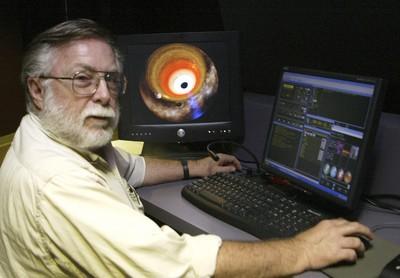Star Bright


A lot has changed at the College of Southern Nevada’s planetarium since its opening 30 years ago.
Back then, the planetarium used slide projectors to help audiences understand astronomy. Then came projectors with clips from videotapes and video discs, plus 70 mm film and automated slide projectors.
But since 2005, it’s all being done digitally with the Digistar 3 system, which incorporates a high definition video projector with a fisheye lens to project images on the planetarium’s 30-foot-diameter screen.
Dale Etheridge has seen all of the changes in technology that make a planetarium show more involving for the audience. He began working at the then-Clark County Community College in November 1976, three months before the planetarium opened. He is the facility’s first and only director.
While a student at the University of Southern California, Etheridge switched to astronomy from physics and was a lecturer and curator of exhibits at the Griffith Observatory. Following graduation, he was hired as planetarium director at Mount San Antonio College near Pomona, Calif., before taking his current position at the college in North Las Vegas.
The planetarium’s new equipment can show star fields and planets with a much crisper image, and a database can calculate star locations.
"We’re doing virtual reality here now," Etheridge says.
The room, which seats 70, is used an average of 40 hours a week when astronomy classes are in session.
Field trips from local schools are accommodated at the planetarium. "With field trips, we consider ourselves more of a motivational tool," Etheridge says.
Planetarium manager Robert Pippin, who has been at CSN for more than 20 years, helps run the shows.
"I have the best job in the world," he says. "They buy these toys and I get to play with them."
Adjacent to the planetarium on the east side of the Cheyenne campus, three telescopes — 6-inch refracting, 12-inch reflecting and 16-inch reflecting — are used for classes and for night sky observation by the public following the shows.
"Stars of the Pharaohs," which takes viewers to ancient Egypt for a look at how astronomy told time and was used to make a calendar, as well as to align large buildings, is currently on view. It will be replaced Aug. 31 by "Origins of Life," a show about the origin and evolution of life in the universe.
"Stars of the Pharaohs" is presented at 6 and 7:30 p.m. Fridays and 7:30 p.m. Saturdays, while the "Larry, Cat in Space" matinee show runs at 3:30 p.m. Saturdays.
"Sky Watch," telescope viewing in the planetarium’s student observatory, follows each night’s show.
The planetarium’s Astronomy Store, featuring toys and educational tools, is open from 5 to 9 p.m. Fridays and 3 to 9 p.m. Saturdays.
what: College of Southern Nevada’s planetarium when: 6 and 7:30 p.m. today, 3:30 and 7:30 p.m. Saturday where: CSN, 3200 E. Cheyenne Ave., North Las Vegas tickets: $4-$6 (651-4759)











